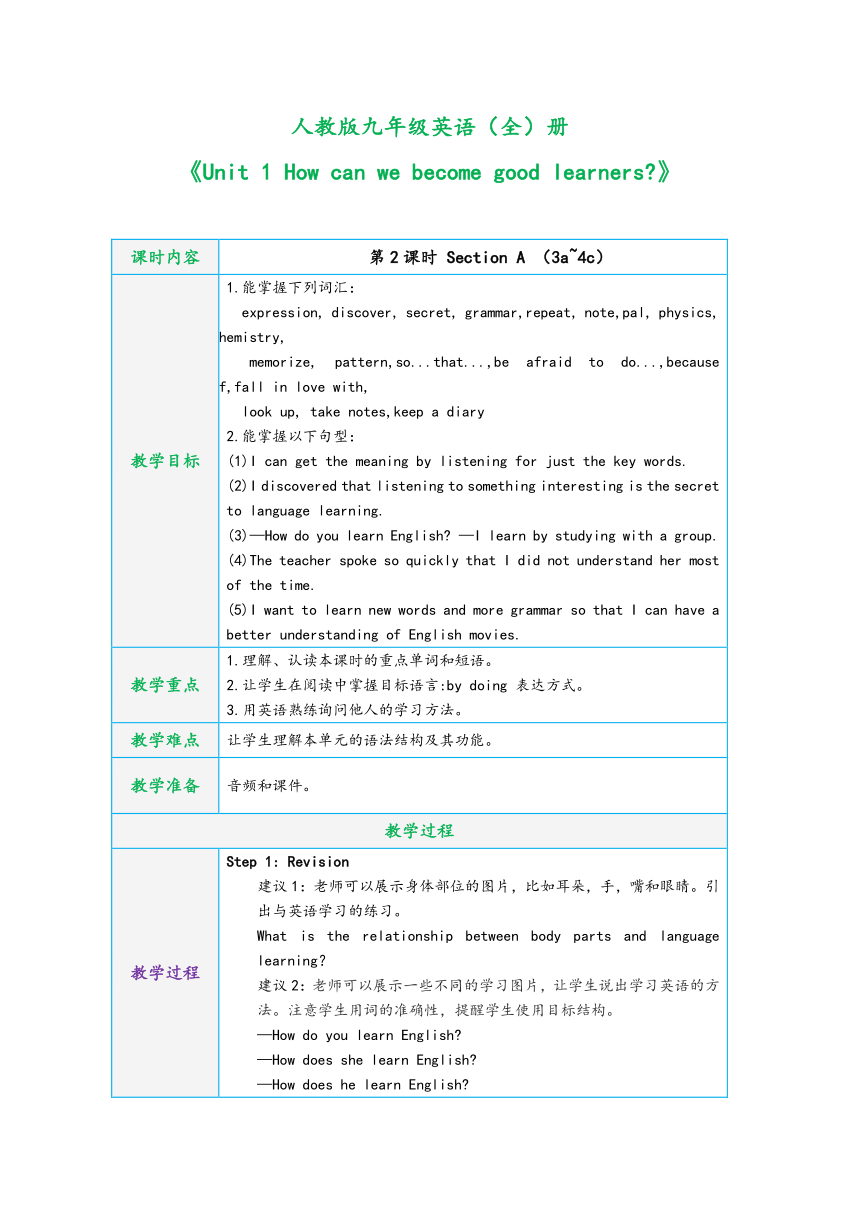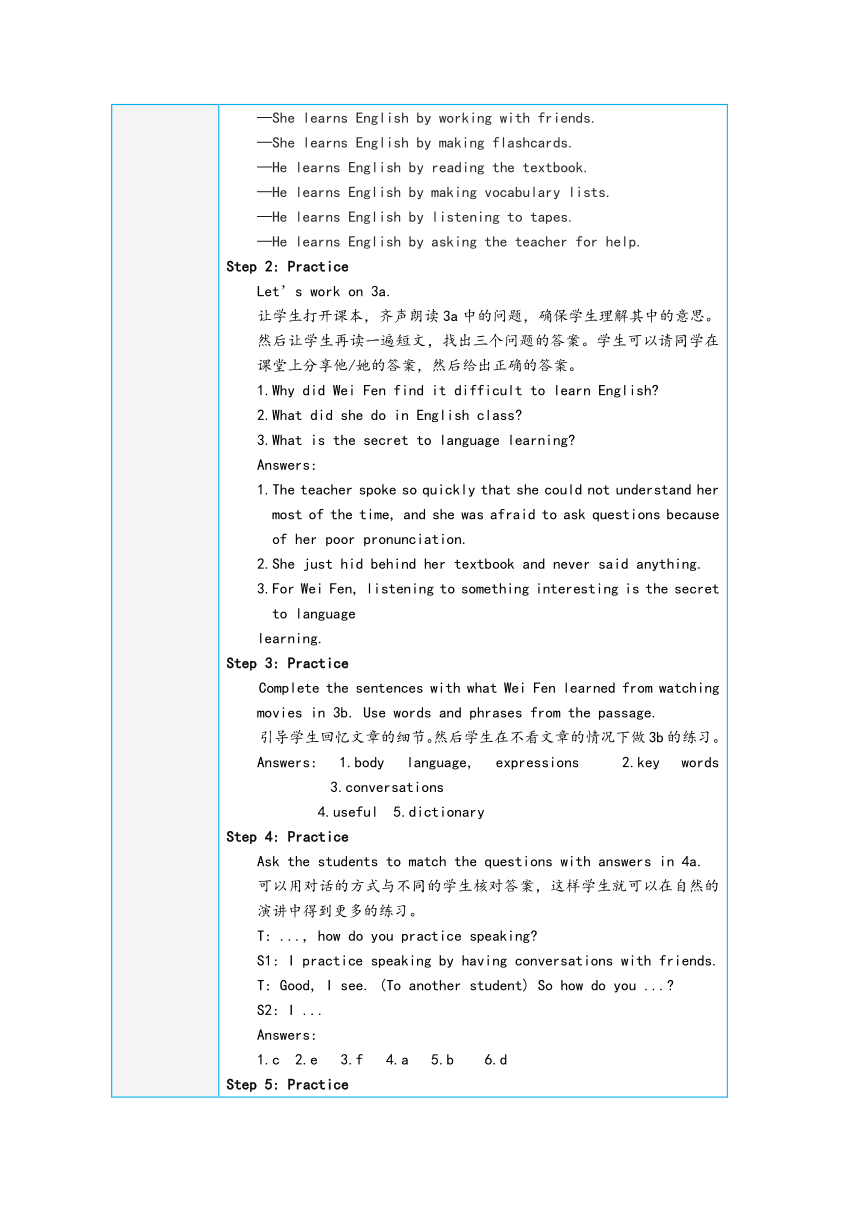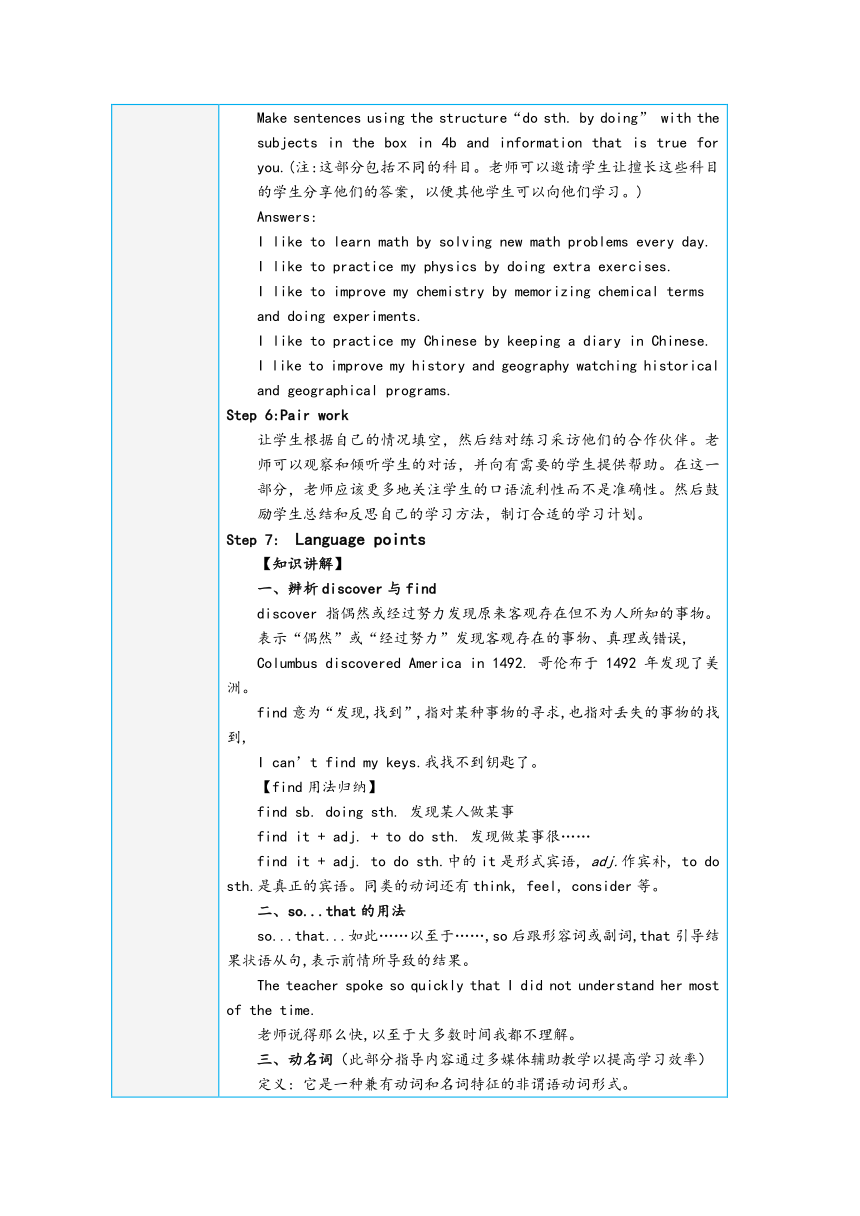人教版九年级英语全册 Unit 1 How can we become good learners?第2课时 Section A(3a-4c)教学设计(表格式)
文档属性
| 名称 | 人教版九年级英语全册 Unit 1 How can we become good learners?第2课时 Section A(3a-4c)教学设计(表格式) |  | |
| 格式 | docx | ||
| 文件大小 | 31.6KB | ||
| 资源类型 | 教案 | ||
| 版本资源 | 人教新目标(Go for it)版 | ||
| 科目 | 英语 | ||
| 更新时间 | 2024-05-29 22:34:18 | ||
图片预览



文档简介
人教版九年级英语(全)册
《Unit 1 How can we become good learners 》
课时内容 第2课时 Section A (3a~4c)
教学目标 1.能掌握下列词汇: expression, discover, secret, grammar,repeat, note,pal, physics, chemistry, memorize, pattern,so...that...,be afraid to do...,because of,fall in love with, look up, take notes,keep a diary 2.能掌握以下句型: (1)I can get the meaning by listening for just the key words. (2)I discovered that listening to something interesting is the secret to language learning. (3)—How do you learn English —I learn by studying with a group. (4)The teacher spoke so quickly that I did not understand her most of the time. (5)I want to learn new words and more grammar so that I can have a better understanding of English movies.
教学重点 1.理解、认读本课时的重点单词和短语。 2.让学生在阅读中掌握目标语言:by doing 表达方式。 3.用英语熟练询问他人的学习方法。
教学难点 让学生理解本单元的语法结构及其功能。
教学准备 音频和课件。
教学过程
教学过程 Step 1: Revision 建议1:老师可以展示身体部位的图片,比如耳朵,手,嘴和眼睛。引出与英语学习的练习。 What is the relationship between body parts and language learning? 建议2:老师可以展示一些不同的学习图片,让学生说出学习英语的方法。注意学生用词的准确性,提醒学生使用目标结构。 —How do you learn English —How does she learn English —How does he learn English —She learns English by working with friends. —She learns English by making flashcards. —He learns English by reading the textbook. —He learns English by making vocabulary lists. —He learns English by listening to tapes. —He learns English by asking the teacher for help. Step 2: Practice Let’s work on 3a. 让学生打开课本,齐声朗读3a中的问题,确保学生理解其中的意思。然后让学生再读一遍短文,找出三个问题的答案。学生可以请同学在课堂上分享他/她的答案,然后给出正确的答案。 1.Why did Wei Fen find it difficult to learn English 2.What did she do in English class 3.What is the secret to language learning Answers: 1.The teacher spoke so quickly that she could not understand her most of the time, and she was afraid to ask questions because of her poor pronunciation. 2.She just hid behind her textbook and never said anything. 3.For Wei Fen, listening to something interesting is the secret to language learning. Step 3: Practice Complete the sentences with what Wei Fen learned from watching movies in 3b. Use words and phrases from the passage. 引导学生回忆文章的细节。然后学生在不看文章的情况下做3b的练习。 Answers: 1.body language, expressions 2.key words 3.conversations 4.useful 5.dictionary Step 4: Practice Ask the students to match the questions with answers in 4a. 可以用对话的方式与不同的学生核对答案,这样学生就可以在自然的演讲中得到更多的练习。 T: ..., how do you practice speaking S1: I practice speaking by having conversations with friends. T: Good, I see. (To another student) So how do you ... S2: I ... Answers: 1.c 2.e 3.f 4.a 5.b 6.d Step 5: Practice Make sentences using the structure“do sth. by doing” with the subjects in the box in 4b and information that is true for you.(注:这部分包括不同的科目。老师可以邀请学生让擅长这些科目的学生分享他们的答案,以便其他学生可以向他们学习。) Answers: I like to learn math by solving new math problems every day. I like to practice my physics by doing extra exercises. I like to improve my chemistry by memorizing chemical terms and doing experiments. I like to practice my Chinese by keeping a diary in Chinese. I like to improve my history and geography watching historical and geographical programs. Step 6:Pair work 让学生根据自己的情况填空,然后结对练习采访他们的合作伙伴。老师可以观察和倾听学生的对话,并向有需要的学生提供帮助。在这一部分,老师应该更多地关注学生的口语流利性而不是准确性。然后鼓励学生总结和反思自己的学习方法,制订合适的学习计划。 Step 7: Language points 【知识讲解】 一、辨析discover与find discover指偶然或经过努力发现原来客观存在但不为人所知的事物。表示“偶然”或“经过努力”发现客观存在的事物、真理或错误, Columbus discovered America in 1492. 哥伦布于1492年发现了美洲。 find意为“发现,找到”,指对某种事物的寻求,也指对丢失的事物的找到, I can’t find my keys.我找不到钥匙了。 【find用法归纳】 find sb. doing sth. 发现某人做某事 find it + adj. + to do sth. 发现做某事很…… find it + adj. to do sth.中的it是形式宾语, adj.作宾补, to do sth.是真正的宾语。同类的动词还有think, feel, consider等。 so...that的用法 so...that...如此……以至于……,so后跟形容词或副词,that引导结果状语从句,表示前情所导致的结果。 The teacher spoke so quickly that I did not understand her most of the time. 老师说得那么快,以至于大多数时间我都不理解。 三、动名词(此部分指导内容通过多媒体辅助教学以提高学习效率) 定义: 它是一种兼有动词和名词特征的非谓语动词形式。 基本形式: V.-ing 作用: 动名词具有名词的性质,在句中可以做主语、表语、宾语、定语等。 动名词的基本用法 1. 用作主语 所表动作比较抽象,或者泛指习惯性的动作。 Playing with fire is dangerous.玩火是危险的。 注意:动名词作主语,有时先用it作形式主语,把动名词置于句末。这种用法在习惯句型中常用。 It is no use/ good / useless + doing… It is a waste of time + doing … It is fun + doing … 在以上结构中常用动名词作主语。 It’s no use crying over spilt milk. 覆水难收。 It is fun playing with children. 和孩子们一起玩真好。 2. 用作宾语 (1)作动词的宾语 常见的此类动词有:practise, enjoy, finish, give up, cannot help, keep, keep on, mind, miss, put off, depend on, think about, succeed in, worry about, be used to, get used to, look forward to, pay attention to等。 How do you practice speaking 你是怎样练习口语的 I have to finish reading a book and give a report. 我必须读完一本书,然后做报告。 (2)作介词的宾语 I learn English by doing grammar exercises. 我通过做语法练习来学英语。 Shall we have a rest or get down to doing our work 我们是休息一下还是开始工作呢 He was late again because of getting up late. 因为起晚了,他又迟到了。 Lock the doors and windows before going out. 出门前锁好门窗。 What/How about the two of us playing games? 我们俩玩游戏怎么样 (3) 既可接动名词又可接不定式的常用动词有: remember, forget, regret, mean, try等,但表达的意义不同。 I remember seeing her at the hotel. 我记得在宾馆见过她。(动作发生了) I will remember to see her at the hotel. 我记着要去宾馆见她。(动作尚未发生) remember/forget/ regret to do 动作尚未发生 remember/forget/ regret doing动作已经发生 try to do设法、努力去做,尽力 try doing 试试去做(看有何结果) mean to do 打算做(主语一般是人) mean doing 意味着(主语一般是物) regret to do 对将要做的事抱歉 regret doing对已经发生的事感到后悔 stop to do停下去做另外一件事 stop doing停止做手头的事情 3. 作表语 动名词作表语时句子主语常是表示无生命的事物的名词或what引导的名词性从句。表语动名词与主语通常是对等的关系,表示主语的内容,主语、表语可互换位置。 Your task is cleaning the windows. 你的任务就是擦窗户。(Cleaning the windows is your task.) What I hate most is being laughed at. 我最痛恨的就是被别人嘲笑。 (Being laughed at is what I hate most.) 动名词有时态和语态的变化。 动名词的时态和语态的基本形式:(以write为例) 注意:动名词的否定形式是:not writing 语态一般时完成时主动语态writinghaving written被动语态being writtenhaving been written
动名词的复合结构: 动名词的逻辑主语+动名词=动名词的复合结构 Would you mind _____(我开窗户吗)? Would you mind my / me opening the window my/ me 称为动名词的逻辑主语。 I can’t understand Jack /Jack’s leaving his wife. I can’t understand his/him leaving his wife. Jack’s/ His leaving his wife is unbelievable. Step 8: Exercises 一、单项选择 1.—Can you tell me your to success —There’s no easy way to learn English well.Just work hard. A.secret B.trouble C.rule D.story 2.In the 19th century,gold was in California. A.discovered B.invented C.seen D.created 3.—Excuse me.Do you know Mr Smith’s phone number —Sorry.But you can in this phone book. A.look up it B.look up them C.look it up D.look them up 4.I find difficult to understand spoken English. A.that B.this C.it D.them 5.My Spanish teacher spoke quickly I could hardly understand him. A.too;to B.such;that C.so;that D.very;that 二、 完成句子 1.我第一次来到香港,就爱上了这个城市。 I Hong Kong when I first came here. 2.当你说英语时,不要害怕犯错误。 Don’t make mistakes when you speak English. 3.他们早起床以便按时赶到车站。 They got up early they can get to the station on time. 4.一个人在水塘里游泳是很危险的。 in the pool alone dangerous. 5.——我们能通过这次化学考试吗 ——小菜一碟。 —Can we pass the chemistry exam —It’s . Answers: 一、1-5 AACCC 二、1.fell in love with 2.be afraid to 3.so that 4.Swimming;is 5.a piece of cake
课堂作业 1.Write a short passage about how to learn English well. 2. Recite the important sentences in the passage on page 3. Try to retell the passage in 3a. 3. Remember the words and phrases in this lesson. 4. Preview the new words in Section B.
板书设计 Unit 1 How can we become good learners Section A(3a~4c) Key sentences: 1.—How can I improve my pronunciation —One way is by listening to tapes. 2.—How can I read faster —You can read faster by reading word groups. Grammar: 1. 动名词的基本用法; 2. 介词by的用法。
教学反思 在这一时期,我们应该在阅读和口语活动中多练习目的语。此外,我们可以设置一些合适的任务来帮助学生进行阅读理解,以提高他们的阅读技能。对于高水平的学生,我们可以为他们提供一些扩展阅读任务或材料。
《Unit 1 How can we become good learners 》
课时内容 第2课时 Section A (3a~4c)
教学目标 1.能掌握下列词汇: expression, discover, secret, grammar,repeat, note,pal, physics, chemistry, memorize, pattern,so...that...,be afraid to do...,because of,fall in love with, look up, take notes,keep a diary 2.能掌握以下句型: (1)I can get the meaning by listening for just the key words. (2)I discovered that listening to something interesting is the secret to language learning. (3)—How do you learn English —I learn by studying with a group. (4)The teacher spoke so quickly that I did not understand her most of the time. (5)I want to learn new words and more grammar so that I can have a better understanding of English movies.
教学重点 1.理解、认读本课时的重点单词和短语。 2.让学生在阅读中掌握目标语言:by doing 表达方式。 3.用英语熟练询问他人的学习方法。
教学难点 让学生理解本单元的语法结构及其功能。
教学准备 音频和课件。
教学过程
教学过程 Step 1: Revision 建议1:老师可以展示身体部位的图片,比如耳朵,手,嘴和眼睛。引出与英语学习的练习。 What is the relationship between body parts and language learning? 建议2:老师可以展示一些不同的学习图片,让学生说出学习英语的方法。注意学生用词的准确性,提醒学生使用目标结构。 —How do you learn English —How does she learn English —How does he learn English —She learns English by working with friends. —She learns English by making flashcards. —He learns English by reading the textbook. —He learns English by making vocabulary lists. —He learns English by listening to tapes. —He learns English by asking the teacher for help. Step 2: Practice Let’s work on 3a. 让学生打开课本,齐声朗读3a中的问题,确保学生理解其中的意思。然后让学生再读一遍短文,找出三个问题的答案。学生可以请同学在课堂上分享他/她的答案,然后给出正确的答案。 1.Why did Wei Fen find it difficult to learn English 2.What did she do in English class 3.What is the secret to language learning Answers: 1.The teacher spoke so quickly that she could not understand her most of the time, and she was afraid to ask questions because of her poor pronunciation. 2.She just hid behind her textbook and never said anything. 3.For Wei Fen, listening to something interesting is the secret to language learning. Step 3: Practice Complete the sentences with what Wei Fen learned from watching movies in 3b. Use words and phrases from the passage. 引导学生回忆文章的细节。然后学生在不看文章的情况下做3b的练习。 Answers: 1.body language, expressions 2.key words 3.conversations 4.useful 5.dictionary Step 4: Practice Ask the students to match the questions with answers in 4a. 可以用对话的方式与不同的学生核对答案,这样学生就可以在自然的演讲中得到更多的练习。 T: ..., how do you practice speaking S1: I practice speaking by having conversations with friends. T: Good, I see. (To another student) So how do you ... S2: I ... Answers: 1.c 2.e 3.f 4.a 5.b 6.d Step 5: Practice Make sentences using the structure“do sth. by doing” with the subjects in the box in 4b and information that is true for you.(注:这部分包括不同的科目。老师可以邀请学生让擅长这些科目的学生分享他们的答案,以便其他学生可以向他们学习。) Answers: I like to learn math by solving new math problems every day. I like to practice my physics by doing extra exercises. I like to improve my chemistry by memorizing chemical terms and doing experiments. I like to practice my Chinese by keeping a diary in Chinese. I like to improve my history and geography watching historical and geographical programs. Step 6:Pair work 让学生根据自己的情况填空,然后结对练习采访他们的合作伙伴。老师可以观察和倾听学生的对话,并向有需要的学生提供帮助。在这一部分,老师应该更多地关注学生的口语流利性而不是准确性。然后鼓励学生总结和反思自己的学习方法,制订合适的学习计划。 Step 7: Language points 【知识讲解】 一、辨析discover与find discover指偶然或经过努力发现原来客观存在但不为人所知的事物。表示“偶然”或“经过努力”发现客观存在的事物、真理或错误, Columbus discovered America in 1492. 哥伦布于1492年发现了美洲。 find意为“发现,找到”,指对某种事物的寻求,也指对丢失的事物的找到, I can’t find my keys.我找不到钥匙了。 【find用法归纳】 find sb. doing sth. 发现某人做某事 find it + adj. + to do sth. 发现做某事很…… find it + adj. to do sth.中的it是形式宾语, adj.作宾补, to do sth.是真正的宾语。同类的动词还有think, feel, consider等。 so...that的用法 so...that...如此……以至于……,so后跟形容词或副词,that引导结果状语从句,表示前情所导致的结果。 The teacher spoke so quickly that I did not understand her most of the time. 老师说得那么快,以至于大多数时间我都不理解。 三、动名词(此部分指导内容通过多媒体辅助教学以提高学习效率) 定义: 它是一种兼有动词和名词特征的非谓语动词形式。 基本形式: V.-ing 作用: 动名词具有名词的性质,在句中可以做主语、表语、宾语、定语等。 动名词的基本用法 1. 用作主语 所表动作比较抽象,或者泛指习惯性的动作。 Playing with fire is dangerous.玩火是危险的。 注意:动名词作主语,有时先用it作形式主语,把动名词置于句末。这种用法在习惯句型中常用。 It is no use/ good / useless + doing… It is a waste of time + doing … It is fun + doing … 在以上结构中常用动名词作主语。 It’s no use crying over spilt milk. 覆水难收。 It is fun playing with children. 和孩子们一起玩真好。 2. 用作宾语 (1)作动词的宾语 常见的此类动词有:practise, enjoy, finish, give up, cannot help, keep, keep on, mind, miss, put off, depend on, think about, succeed in, worry about, be used to, get used to, look forward to, pay attention to等。 How do you practice speaking 你是怎样练习口语的 I have to finish reading a book and give a report. 我必须读完一本书,然后做报告。 (2)作介词的宾语 I learn English by doing grammar exercises. 我通过做语法练习来学英语。 Shall we have a rest or get down to doing our work 我们是休息一下还是开始工作呢 He was late again because of getting up late. 因为起晚了,他又迟到了。 Lock the doors and windows before going out. 出门前锁好门窗。 What/How about the two of us playing games? 我们俩玩游戏怎么样 (3) 既可接动名词又可接不定式的常用动词有: remember, forget, regret, mean, try等,但表达的意义不同。 I remember seeing her at the hotel. 我记得在宾馆见过她。(动作发生了) I will remember to see her at the hotel. 我记着要去宾馆见她。(动作尚未发生) remember/forget/ regret to do 动作尚未发生 remember/forget/ regret doing动作已经发生 try to do设法、努力去做,尽力 try doing 试试去做(看有何结果) mean to do 打算做(主语一般是人) mean doing 意味着(主语一般是物) regret to do 对将要做的事抱歉 regret doing对已经发生的事感到后悔 stop to do停下去做另外一件事 stop doing停止做手头的事情 3. 作表语 动名词作表语时句子主语常是表示无生命的事物的名词或what引导的名词性从句。表语动名词与主语通常是对等的关系,表示主语的内容,主语、表语可互换位置。 Your task is cleaning the windows. 你的任务就是擦窗户。(Cleaning the windows is your task.) What I hate most is being laughed at. 我最痛恨的就是被别人嘲笑。 (Being laughed at is what I hate most.) 动名词有时态和语态的变化。 动名词的时态和语态的基本形式:(以write为例) 注意:动名词的否定形式是:not writing 语态一般时完成时主动语态writinghaving written被动语态being writtenhaving been written
动名词的复合结构: 动名词的逻辑主语+动名词=动名词的复合结构 Would you mind _____(我开窗户吗)? Would you mind my / me opening the window my/ me 称为动名词的逻辑主语。 I can’t understand Jack /Jack’s leaving his wife. I can’t understand his/him leaving his wife. Jack’s/ His leaving his wife is unbelievable. Step 8: Exercises 一、单项选择 1.—Can you tell me your to success —There’s no easy way to learn English well.Just work hard. A.secret B.trouble C.rule D.story 2.In the 19th century,gold was in California. A.discovered B.invented C.seen D.created 3.—Excuse me.Do you know Mr Smith’s phone number —Sorry.But you can in this phone book. A.look up it B.look up them C.look it up D.look them up 4.I find difficult to understand spoken English. A.that B.this C.it D.them 5.My Spanish teacher spoke quickly I could hardly understand him. A.too;to B.such;that C.so;that D.very;that 二、 完成句子 1.我第一次来到香港,就爱上了这个城市。 I Hong Kong when I first came here. 2.当你说英语时,不要害怕犯错误。 Don’t make mistakes when you speak English. 3.他们早起床以便按时赶到车站。 They got up early they can get to the station on time. 4.一个人在水塘里游泳是很危险的。 in the pool alone dangerous. 5.——我们能通过这次化学考试吗 ——小菜一碟。 —Can we pass the chemistry exam —It’s . Answers: 一、1-5 AACCC 二、1.fell in love with 2.be afraid to 3.so that 4.Swimming;is 5.a piece of cake
课堂作业 1.Write a short passage about how to learn English well. 2. Recite the important sentences in the passage on page 3. Try to retell the passage in 3a. 3. Remember the words and phrases in this lesson. 4. Preview the new words in Section B.
板书设计 Unit 1 How can we become good learners Section A(3a~4c) Key sentences: 1.—How can I improve my pronunciation —One way is by listening to tapes. 2.—How can I read faster —You can read faster by reading word groups. Grammar: 1. 动名词的基本用法; 2. 介词by的用法。
教学反思 在这一时期,我们应该在阅读和口语活动中多练习目的语。此外,我们可以设置一些合适的任务来帮助学生进行阅读理解,以提高他们的阅读技能。对于高水平的学生,我们可以为他们提供一些扩展阅读任务或材料。
同课章节目录
- Unit 1 How can we become good learners.
- Section A
- Section B
- Unit 2 I think that mooncakes are delicious!
- Section A
- Section B
- Unit 3 Could you please tell me where the restroom
- Section A
- Section B
- Unit 4 I used to be afraid of the dark.
- Section A
- Section B
- Unit 5 What are the shirts made of?
- Section A
- Section B
- Review of Units 1-5
- Unit 6 When was it invented?
- Section A
- Section B
- Unit 7 Teenagers should be allowed to choose their
- Section A
- Section B
- Unit 8 It must belong to Carla.
- Section A
- Section B
- Unit 9 I like music that I can dance to.
- Section A
- Section B
- Unit 10 You're supposed to shake hands.
- Section A
- Section B
- Review of Units 6-10
- Unit 11 Sad movies make me cry.
- Section A
- Section B
- Unit 12 Life is full of the unexpected
- Section A
- Section B
- Unit 13 We're trying to save the earth!
- Section A
- Section B
- Unit 14 I remember meeting all of you in Grade 7.
- Section A
- Section B
- Review of Units 11-14
